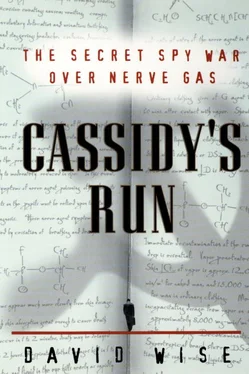Although sentenced to two years, Libman was let out after one year because nobody else could start up production of soman at the Volgograd works. The soman production plant opened, with Libman back on the job, in 1968.
In 1972, Libman was transferred to Novocheboksarsk to oversee the full-scale production of VX. The Soviets, however, were not content with mass production of soman, sarin, and VX. Two scientists, Pyotr Petrovich Kirpichev and Vladimir Uglev, were working at Shikhany 1 on a new nerve gas, the like of which the world had never seen before.
Whether the formula for GJ that was passed to Moscow in Operation SHOCKER inspired this Soviet effort may never be known without access to the closed archives of the GRU. But in 1973, Kirpichev and Uglev perfected the new substance, said to be eight to ten times more powerful than any nerve gas then in existence.
Its name, which means “newcomer” in Russian, was Novichok.
In 1968, JoeCassidy was living in an apartment building on Moravia Road in Baltimore and commuting to his job at Edgewood Arsenal. He noticed the attractive high-school teacher who lived in an apartment one floor above him, but they had only a nodding acquaintance.
Marie Krstyen in turn was aware of the tall, good-looking sergeant. Occasionally, she glanced out the window and watched him play catch with his son, Barry, who lived with his mother in Alexandria but visited on weekends.
Early in March of that year, the wife of another tenant in the building left in a huff, after stripping the apartment clean. The distraught husband was wandering the hall. Marie Krstyen and Cassidy took pity on the fellow and tried to calm him down. The wandering wife returned in a few days, and Marie and Cassidy started dating. She was forty and had never married; Cassidy was forty-seven.
“On the first date, he took me to the Playboy Club,” she recalled. Krstyen was not sure that his choice was such a great idea, but Cassidy, a member, was fond of the prix fixe menu; drinks were only $1.50, as was dinner. On his sergeant’s salary, he considered the place a bargain. As the waitresses in their brief, cottontail outfits ministered to the couple, Cassidy began probing to find out more about his new friend’s background. For Krstyen, it was a turnoff.
“He kept asking a lot of personal questions,” she said. “I didn’t like that at all.”
Marie Krstyen, of course, had no way of knowing why her date was asking so many questions. In part, Cassidy grilled her out of normal curiosity. However, while he did not need the FBI’s permission to see a woman, he was aware that the bureau would want to know as much as possible about anyone he was dating. If it turned serious, he knew, they would have to do a background check.
Despite getting off on the wrong foot that first evening, Cassidy soon recovered and made a decided impression on his schoolmarm neighbor. “He swept me off my feet,” she said. “There was something about him that got me. He seemed a very loyal and truthful guy. He seemed genuine.” Since Cassidy was living a double life and pretending to the Russians that he was a money-grubbing traitor, he was anything but genuine. But Marie Krstyen had fallen in love.
“He had good manners, he always greeted people, he was a perfect gentleman. Everybody called him the Sarge, and everybody loved him. I was teaching at night, and Joe always checked to make sure I got home.
“I usually went to his place for dinner, because he did the cooking. In the latter part of April, at dinner at his apartment, he presented me with an engagement ring. He just floored me. But I did accept it, and I’d had nothing to drink.”
Cassidy remembers the scene about the same way, with one nuance. Marie, he said, had hesitated. “She sat there looking at the ring. But finally, she said, ‘Yes.’ I put it on her finger. The next day her students whispered, ‘Miss Krstyen’s engaged.’ It went around like wildfire.
“Within a few days I told the bureau I was going to get married. I had already told them I was dating her. So in March the bureau had started checking her out.”
What happened next alarmed the FBI and dismayed Cassidy as well. “Marie had mentioned she came up from Atlanta. And I knew she was a teacher, but anything else I didn’t know. So I told the bureau she was from Atlanta, and they couldn’t find any trace of her.
“So I queried her some more, what did you do in Atlanta? And finally she said she came from Montgomery, from Alabama.” Still, the FBI could not find any trace of Krstyen. And why had she changed her story? She seemed to have materialized in Baltimore out of thin air without any past history. Yet that was impossible. Could Krstyen be a Soviet swallow? That was the term that Russian intelligence used for a female agent dispatched to seduce a male target. Perhaps the innocent-looking schoolteacher was actually a Russian working for the GRU, sent to check up on Cassidy’s bona fides.
Finally, the FBI solved the mystery. For twenty years, Marie Elizabeth Krstyen had been Sister Miriam Joseph of the Vincentian Sisters of Charity. For part of the time, she had lived behind the walls of a convent. Small wonder that the FBI had trouble with its background check.
Cassidy was relieved at the news, although slightly embarrassed that he had taken an ex-nun to the Playboy Club. But he wondered why Krstyen had not revealed her previous life.
“I never told him I had been a nun,” she said, “because I wanted him to be himself. I didn’t want him to act different.”
But Cassidy had not revealed his secret either. “I never told her about my other life,” he said.
In a sort of gift-of-the-magi, O. Henry twist, Marie Krstyen née Sister Miriam Joseph, and Joe Cassidy, aka WALLFLOWER, had concealed their secrets from each other. Even as their wedding date approached, Cassidy was still not authorized by the FBI to tell her the truth. She did not yet know the extent to which her own life was to change when she married a spy.
But why had Krstyen told Cassidy she had come up from Atlanta? “I did say Atlanta,” she recalled, “but all I meant was I changed planes in Atlanta. I had come from Montgomery. I did spend about a week in Atlanta with friends.”
Marie’s father, John Krstyen, was born in Czechoslovakia and came to America as a child of ten. Her grandfather was Hungarian; later, she wondered if her Eastern European family background had added to the FBI’s concern when the bureau finally figured out who she was.
Marie Krstyen was born on March 20, 1927, in Johnstown, Pennsylvania, where her father worked for Bethlehem Steel, fixing machinery. Her mother, Mary Kondash, was the daughter of a local businessman. “Our family was Catholic, my mother converted when we were small. I went to a parochial school, and I wanted to be a teacher, so the nuns said, ‘Join the convent.’ It was a way of getting a college education.”
She had entered the convent, which was in Pittsburgh, at age eighteen. Even early on, there were harbingers of her eventual decision to return to the secular life. Sister Miriam alone would not bow her head during prayer before mealtime and was admonished by the nuns. She was told she was too proud, and was not showing the proper degree of humility. “But I felt humility is truth. And if my feelings were the truth, then why should I bow my head? I consider religion very personal, between you and your God.”
For any infractions of the rules, the nuns were forced to kneel at the crucifix in front of some three hundred other nuns in the cafeteria and eat their meals on their knees. Independent-minded, and a touch rebellious, Sister Miriam questioned the practice. She was required to eat several meals on her knees, however, for minor transgressions.
Читать дальше












